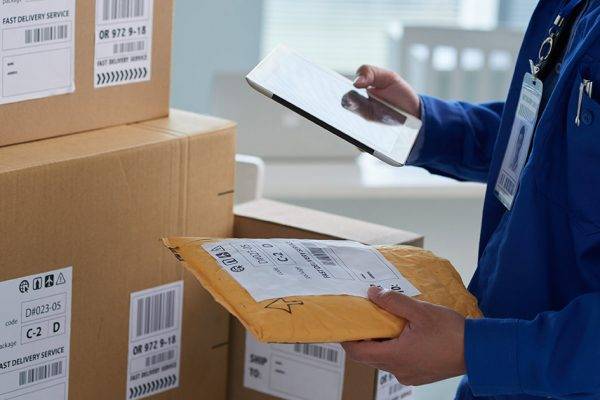Ecommerce shipping solutions for selling online

So you have your products. You have an e-commerce website or are planning to get one. Either way, once you sell your products online, how are you going to get your products to your customers? You have two main options for this; let your customers buy online and come and pick it up from you, or ship it out to them. Finding an e-commerce shipping solution can be one of the most complex parts of selling online, so how can you make it easier for both you and your customers?
In order to get your online store ready for the customers, you need to pick a shipping option and a freight method for actually delivering the product to your customer.
Pre-shipping checklist
Before deciding on what to charge the customer for shipping, you need to find out how much shipping will cost the business. This will depend on the carrier you choose. You’ll also need to decide on packaging and labelling.
Shipping costs to the business
Even if you decided to offer free shipping, that free shipping won’t be free to you. There are many options for couriers in New Zealand such as Post Haste, Mainfreight, NZ Post, and New Zealand Couriers. No matter which company you go with, shipping is charged based on weight and dimensions–or what can fit in a package. Most companies will have a shipping calculator to easily calculate rates. Many have it as an API–meaning you can have these costs shown directly on your website if you plan on passing them directly to the customer.
As a business, you’re eligible to get discounts and additional services from many freight companies. They can also pick up your parcels for delivery on a regular schedule at your business. With the right setup, you can have tracking emails sent automatically too.
If deciding on courier options is overwhelming, a freight service like parcelpost or gosweetspot can help. These services have updated rates for their partner couriers and calculate freight fees in real-time. They can help you get the best value company for your specific item based on shipping time, cost, and extras. Of course, there’s an additional cost to use the service but some businesses will save in the long run because of the option to use different companies for different items.
At a minimum, expect to spend around $5 to ship a product to a customer, with increased costs depending on product dimensions.
Save out your product dimensions
When you add a new product to your store, one of the first things you should do is save out the dimensions. If you have a good Inventory Management system you can add them there for easy storage and safekeeping. Some will even calculate shipping for you based on your chosen freight providers.
If you don’t, you’ll need to record these details somewhere and keep them in a database. It will likely take some time to get this done for all your products. But doing it upfront can save you time when it’s actually time to order, since you won’t have to weigh out your products and make sure you choose the right size parcel.
Packaging and labelling
Many freight companies let you get boxes directly from them. As the boxes may be sized according to their pricing model, this is often a strong option for businesses to consider. It’s also the most straightforward option.
However, you don’t have to use boxes from the company. Some businesses have a steady supply of boxes on hand that they can reuse without having to pay for more.
On the opposite end, you can go all in and get custom-branded boxes and packaging. Companies like The Box Business, Fast Printing, and r3pack offer customised boxes and/or packaging you can use when shipping products. These costs can add up quickly, and aren’t ideal for every business, but can be an excellent way to get more branding out there and help your business to look more professional.
Most freight companies have specific instructions on how to label your items for shipping. You’ll need to follow these directions precisely to ensure the package can be delivered properly.
However, you can also add a label for your business if you’d like. You can make these yourself or use a service like vistaprint for custom stickers. These can be used as labels or as a more affordable way to brand your items compared to fully-branded boxes.
What are my options for shipping?
Once you have the costs of shipping for the business, you need to decide how much of that to charge the customer. There are three main types of ways to ship items: You can do free shipping, you can do flat-rate shipping, or you can charge based on the dimensions and weight of the product. Each e-commerce shipping solution has its own advantages and disadvantages and the right option for you depends on the type of business and its goals.
It’s crucial that you take the time to properly decide which option to go with. Nearly half of people will abandon their purchase if unexpected costs at checkout are too high. When people do abandon a cart for whatever reason, almost 60% say it’s because of high shipping costs. While it might make sense to pass on these costs to your customer, it isn’t always in your best interest as you can lose a lot of sales. If high shipping costs are necessary, we’ll cover some ways to make these more expected to avoid sticker shock.
Free Shipping
Free shipping is the customer’s favourite! In fact, one survey showed that for 90% of customers, free shipping was the best incentive you can get when buying online. But if it costs the business several dollars on each sale, those sales can add up quickly–and the business can even take a loss on small-value transactions.
There are a couple of ways to combat this. One way is to increase the item price. You charge more for each item to help cover the shipping costs. On smaller items you may still have to eat some of the costs, but the larger orders should make up for it. While it may seem counterintuitive, one study showed that free shipping (worth $6.99) was considered more valuable than $10 off the product. Keep in mind this is in the US where services like Amazon Prime have made free shipping the norm, but the point remains that many customers see shipping costs as an extra fee instead of something that adds value. However, adding to the cost of the item is only ideal for e-commerce only stores; some customers are sure to cry foul if they find your in-store prices are cheaper than online.
Free shipping with minimum order
Another option is to add free shipping for orders over a certain amount. This works two-fold; first, it helps stop the business from losing money on small sales. Second, it helps persuade some customers to spend more on your store. If their original order is $68 and they can get free shipping over $75, a lot of people will decide to get more from you to qualify for free shipping. And that might be another $15-20 instead of the bare minimum to qualify.
Many e-commerce platforms can handle this for you automatically if you want to go this route. You simply find where to tell it the minimum order amount for free shipping and it will update the cart automatically once an order exceeds that amount.
How do you decide your free shipping threshold?
A major challenge for many businesses is finding the sweet spot for the free shipping threshold. If you put it too low you risk having to absorb those costs. If you put it too high, it won’t be enticing for customers. So how do you find the right amount?
The sweet spot is different for each business. It depends on your average order value, average shipping costs, and your margin. An article from the Fulfillment Lab goes into threshold calculations in more detail, but the formula comes down to this:
- Put in a number you think is reasonable for free shipping. Subtract your average order value from that amount ($100 (Free Shipping) – $75 (Average order value) = $25)
- Multiply that number by your margin ($25 * 0.50 (Your margin) = $12.50)
- Subtract that number from your average shipping cost ($16 (Average shipping cost) – $12.50 = $3.50)
That final number ($3.50) is the estimated cost to your business per order for offering free shipping. Ideally, you would want it to be a few dollars. If it’s a negative value, your minimum order is probably too high; if you start getting near $10 it’s probably too high. It may take some refining, but free shipping can work in your favour by enticing people to buy more!
Flat rate shipping
With flat rate shipping, you charge a flat rate for shipping on every order. There are no calculations required; shipping costs are the same every time and help you make some of the costs back. In New Zealand, flat rate shipping is a tad more complicated. You’ll usually see four different flat rates: Urban on the same island, rural on the same island, urban on the other island, and rural on the other island.
As this is a normal practice in the country, your customers won’t be surprised to see it. But if you want to go that route, how can you make sure your customer chooses the right option? The easiest way is to have this determined automatically. If you’re using or plan to use a WooCommerce website, you can download the plugin NZ Shipping Zones for WooCommerce plugin. This e-commerce shipping solution was developed by Kiwi web developer Daniel Shaw and takes data from NZ Post’s Postcode Listings for Rural Deliveries. It’s a huge time saver, especially when combined with something like the NZ Post addressing API that auto-fills and corrects addresses based on what NZ post has on file. With this combination, customers simply start typing their address and choose it from the autocomplete list, then the appropriate shipping is chosen automatically.
Flat rate shipping is convenient because customers don’t have to worry about calculating shipping costs. As long as you make it clear what the prices are upfront, customers can browse your shop without getting hit with an unexpected charge later on.
How do you decide on your flat rate price?
There’s no question that flat rate shipping is convenient and easy to use for customers. But how do you make it easy for the business and charge an appropriate amount?
If you’ve already found the shipping costs to the business, you’ll be better set to decide how much of the cost to pass on to customers. Some businesses do it so that small, low-value orders actually make money for the business with flat rate shipping. This helps balance out orders with larger items that will cost the business more.
Other companies keep shipping rates lower to cover some of the cost of shipping. This method covers more of the cost than free shipping but customers with low-value orders may go elsewhere if they think shipping is too high. Some do flat rate except for oversized items, which have calculated shipping. Just make sure to let customers know as soon as possible if their item incurs extra shipping fees.
Calculated Shipping
Calculated Shipping is the easiest way to make sure your costs are covered and that the customer won’t pay more for shipping than the service actually costs. While this is a straightforward way of doing it, it’s also the most likely way that customers will abandon their purchase.
Again, this comes down to expectations. With calculated shipping, visitors can only guess at what the cost will be; if it’s too much higher than they think they’ll probably look somewhere else for the same or similar product. If your items are small and light, calculated shipping can be a good option for everyone. It might be cheaper than flat rate for you and you can pass those savings on to the customer.
Likewise, if you have very large items like heavy appliances, customers won’t expect that to be sent over for a $5 shipping charge. You’ll likely need to work with a freight company that specialises in large packages like Mainfreight or FedEx Express. Depending on the item, you may need to reduce the price on these large items for shipping as well–often customers aren’t thrilled to find out shipping costs more than the product!
Local pickup
If you want to avoid shipping altogether, you can have local pickup only. This is a good option if you already have a strong presence in your local area. So why do this at all instead of having people come to the store to purchase?
Selling online with local pickup offers a few advantages. One of the biggest is that people can shop anytime. According to SaleCycle, the peak time for shopping online is between 8 and 9pm. People are at home and settled in, ready to shop. If your business is available to sell products for these hours, you might pick up some sales. Even if they can’t physically pick it up until the next day or later, by being available when people are shopping you open yourself up to more local sales.
Combining local pickup and delivery
Even if you decide to include a delivery option, also having local pickup may be a good decision. One benefit of doing this is that some people prefer to take it slow and go through your inventory at their own pace. Even if you aren’t pushy in person, for some it’s a better experience to search through your inventory at their own pace out of the store.
Some locals might prefer online shopping but would rather stop in and pick up their order instead of paying for shipping. Or they might be looking for a particular item and want to make sure you have it. Checking online is much more convenient than dropping by to see, and some will go with someone else instead of taking the risk. Having the pickup option makes it simple for them, and you can save on packaging and freight at the same time.
While you can get more sales by including local pickup if it’s viable, you’ll greatly limit your potential for reaching new customers if you don’t include another shipping option. You may have people keen for what you have to offer on the other end of the country. And, with tools like Facebook ads and Google ads, it’s easier than ever to reach people wherever they are.
How do I set up shipping on my website?
Once you’ve decided on a shipping method, you’ll need to enable it on your website. This process will be different depending on which e-commerce platform you use. Most of them will have a “Shipping” tab or have options for Shipping within the settings when you log into the website. The best way to set up shipping is to find the resource written by the platform. Here are some instructional guides for the most popular platforms in NZ:
- WooCommerce – How to Implement a Shipping Strategy
- Shopify – Ecommerce Shipping and Fulfillment: A Complete Guide
- OpenCart – Shipping
- Squarespace – Setting up shipping rates
- Magento – Setting Up Magento Shipping
Next steps after setting up shipping
After setting up shipping, make sure that your costs and expenses are well-balanced. The only way to know for sure if you set appropriate charges is to try out your strategy with customers. You might find out that your charges or free shipping threshold are too high. Or that they are too low and nobody ever qualifies. Depending on the results, you have several options you can try. You can try engaging a small base of customers with free shipping discount codes. Or offer a percentage off for regular ordering or subscriptions. Or you might want to consider changing carriers if they aren’t meeting your expectations. Once you get everything working and find the best e-commerce shipping solution, delivery simply becomes a normal part of business–only now you can have customers over 1000km away!





